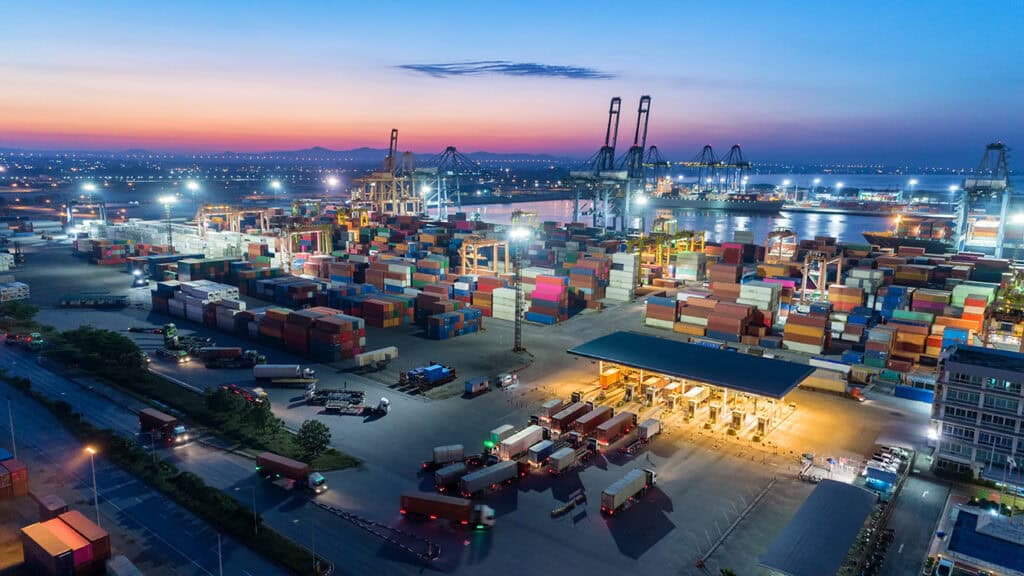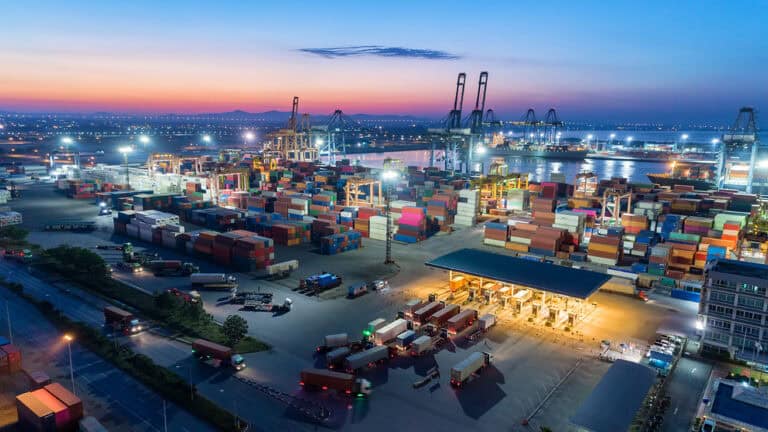
Supply chains are evolving at an unprecedented pace, driven by advancements in technology, shifting geopolitical dynamics, and changing customer expectations. As we move further into 2025, here are five key trends that supply chain professionals and leaders should have on their radar.
Supply chain trend 1: Risk management will take center stage
The era of reactive supply chain management is over (or it should be, anyway). Organizations can no longer afford to simply mop up the milk after it’s already in a puddle on the floor. They need to have the ability to quickly respond to disruptions before or as they occur – and catch the glass, in full superhero mode, before it tips completely over. Proactive strategies supported by advanced analytics and artificial intelligence will help build the “spidey sense” needed to maintain and grow supply chain resilience.
Key components of modern supply chain resilience
Shadow planning with a digital twin
While “shadow planning” may sound like a sinister or mysterious term that jumped out of the page of a fantasy novel, in reality it’s a forward-thinking way for brands to manage outsourced manufacturing. Instead of scrambling to fix problems as they arise, shadow planning allows for brand owners simulate different scenarios, remove supply constraints, and optimize material flows across a complex, multi-tier supply chain. This approach ensures that capacity is allocated effectively, and companies can stay ahead of potential risks or disruptions, such as downed manufacturing equipment, natural disasters, or sudden spikes in demand that could lead to shortages.
Take, for example, an automotive manufacturer who develops shadow plans for potential semiconductor shortages, each pre-validated through simulations to ensure minimal production impact, alternative sourcing strategies, and rapid response mechanisms. Now this is an over simplified example for sake of this blog post, but shadow planning can be applied to hundreds of different manufactured items, including electronics, electric space heaters, solar panels, pencils, etc. The point is, it allows companies to be better prepared to catch that glass of milk before it tips over with pre-modeled contingency plans that can be quickly activated when required.
Where do digital twins come in to play here? Digital twins are the ultimate cornerstone to successful shadow planning. They are virtual models of the entire supply chain network and provide organizations with a way to simulate the various “what-if” scenarios needed in shadow planning. With enhanced visibility from end-to-end, real-time data, and predictive analytics, shadow planning gives brand owners a virtual crystal ball that allows them to make the best possible decisions for their supply chains. Instead of creating plans based purely on historical insights, digital twins allow companies to generate forward-looking, dynamically-adjusted plans.
Investments in demand sensing and multi-echelon inventory optimization
Like an old paper roadmap, traditional, linear forecasting methods that rely primarily on historical data have become obsolete. They fail to capture the nuanced, quickly changing market conditions and leave companies exposed to risks such as increased operational costs, reduced responsiveness, lower customer satisfaction, and ultimately culminate as a competitive disadvantage that can hurt the bottom line – where it counts the most.
Modern forecasting should function more like today’s GPS and navigation apps, which show the immediate picture of traffic conditions like slowdowns, accidents, and road closures that help users adapt their routes instantly. If they haven’t already, companies should consider investments in AI, real-time data integration, and technologies like demand sensing and multi-echelon inventory optimization (MEIO) to boost forecast accuracy and slash safety stock. The evidence speaks for itself: The 2024 Forecasting and Benchmark Study analyzed data from before, after, and during the pandemic, and uncovered that demand sensing cut forecasting error by roughly one-third compared to traditional methods. When paired with MEIO, daily demand sensing forecasts helped companies cut safety stock by as much as half across all stages of the pandemic.
Operational resilience framework and strategy
As we head into the void of the unknown future, what does it hold for supply chain trends? No doubt we will continue to face many of the same challenges that we already do today – rising costs, inefficiencies, blind spots, delays, inventory imbalances…I’m sure you, dear reader, have plenty that you could add to this list. But we are not here to talk about those challenges – known or unknown. We are here to give you the flexible armor your supply chain needs to stay resilient, no matter what wars or battles are headed your way in the coming year.
The “see-understand-act & learn” framework is an essential supply chain strategy for developing that armor and building operational resilience during disruptions. It enables organizations to navigate and succeed in intricate and unpredictable environments by endlessly adjusting their operations, quickly countering disruptions, and maintaining essential activities with minimal downtime or impact on performance.
How to see: With harmonized, real-time data from across the entire end-to-end supply chain network to enhance visibility and knock down silos.
How to understand: By analyzing the data and transforming it into actionable insights for impact analysis and scenario planning.
How to act & learn: Using those insights and AI-based decision-making to collaborate with partners on swift resolution and continually refine strategies to improve responses.
With real-time visibility, predictive insights, and seamless collaboration, an operational resilience strategy rooted in this framework enables organizations to face the challenges ahead and build a more connected, responsive supply chain.
Supply chain trend 2: Geopolitical tensions and trade wars will reshape global trade dynamics
The global trade environment is entering uncharted territory. The new U.S administration has signaled its intent to shake up international commerce with the prioritization of domestic interests, proposing sweeping tariffs on imports from China, Canada, and Mexico. Given that these three nations accounted for 40% of U.S. imports in 2024, the ripple effects of these policies could be profound and will likely introduce new challenges for businesses, economies, and consumers alike.
Beyond the immediate implications of higher costs for raw materials and finished goods, there’s another layer of complexity. These tensions could also reshape existing trade agreements such as the United States-Mexico-Canada Agreement (USMCA) and turn long-standing international partnerships on their heads.
For organizations and supply chain professionals, we’ll all be carefully tiptoeing through a minefield of risks with a new sense of urgency for proactive, strategic planning. Below we’ll explore a few actionable steps companies can take to prepare for the incoming trade uncertainties.
How to navigate trade uncertainties
1. Build flexibility into supplier networks
Map your current entire supplier network, from n-tier to sub-tier suppliers, and identify alternatives in countries where you could potentially diversify your supplier base. Remaining reliant on suppliers from countries directly impacted by trade disputes can leave your business vulnerable to cost volatility.
2. Avoid overstocking to manage potential cost increases
In times of uncertainty, the temptation to stockpile inventory in anticipation of future cost increases is understandable – but it’s a risky move. Excess inventory ties up working capital, increases storage costs, and can lead to product obsolescence. Instead, focus on demand sensing and inventory optimization. Implement smarter planning tools to strike a balance between maintaining adequate stock levels and avoiding the pitfalls that come with overstocking.
3. Optimize trade savings and reduction programs
Companies navigating trade wars must leverage every available opportunity to minimize costs. Special trade programs such as free trade agreements (FTAs), preferential trade programs, and other duty reduction plans can offer substantial savings. To capture the full potential of trade agreements, brands must align supply and manufacturing operations to the requirements of any applicable trade agreements and consider automating the FTA qualification process.
4. Stay current with trade regulations
Invest in tools, subscriptions, or partnerships that keep you updated on the latest developments in trade policy to make timely, informed decisions. The e2open Global Knowledge® database provides organizations with easy access to current trade content, such as sanctions, restricted party lists, and product classification, for over 230 countries.
Sign up for our free Global Trade Management newsletter for weekly trade updates.
The key to long-term success on the global trade playing field will come to companies that develop flexible, technologically advanced, and geographically diverse supply chains balanced on efficiency, resiliency, and adaptability.
Supply chain trend 3: Sustainability and regulatory compliance investments will pay off
Supply chains are facing a pivotal moment as environmental, social, and governance (ESG) considerations move from something that was a “nice-to-have” to a “must-have”. The writing is on the wall: governments worldwide are rolling out stricter regulations to combat climate change, protect human rights, and ensure sustainable business practices. Just look around at some of the regulations already in place – like the European Union’s Carbon Border Adjustment Mechanism (CBAM), or the U.S. Uyghur Forced Labor Prevention Act (UFLPA) to see how they are already reshaping supply chains.
Compliance strategies for supply chain leaders
Improved supplier management: Shine a light on your suppliers
You can’t manage what you can’t see.
Gaining deeper visibility into n-tier suppliers (the ones behind the scenes that you probably don’t even think about) and building an illuminated, deep collaborative network of trusted partners is key to stepping out of the darkness. Investing in tools that can map your supply chain and track supplier data will provide insight into who is aligned to your ESG needs and goals and who is not.
Compliance and audits tracking: Stay one step ahead
ESG regulations are a moving target.
Falling behind new laws and regulations can cost you more than just a slap on the wrist. Non-compliance penalties are expensive and can tank your reputation. To stay on top, you need a way to easily track and monitor evolving regulations, flag potential risks, and keep your business audit-ready.
Invest in compliance and tech: The secret sauce for long-term resiliency
Beyond weatherproofing for today’s storms.
Let’s be honest, “compliance” isn’t the most exciting term in the supply chain world. It’s not flashy like AI or trendy like drones, but here’s the truth: investing in compliance-specific technologies ensures your entire operation can weather whatever comes next. As governments around the globe are tightening regulations and customers are paying more attention to ESG-friendly products, focusing on compliance will not only prevent fines and reputational damage, but it will also generate new interest and build trust with customers and investors.
Supply chain trend 4: Customer-centric supply chains will drive success
Think about this; when was the last time you bought something online and waited patiently for it to arrive at your doorstep? Probably not (that even goes for those of us who were born prior to the dawn of e-commerce). Customers expect fast, reliable service from the moment they click “buy” to the second they have the item in their hands. Supply chains must be designed to meet those expectations, delivering not only products, but confidence and convenience.
Speed isn’t the only factor to consider. Transparency, personalization, and delivery excellence all play a role in creating the golden level of customer service. Companies that can nail these elements will build long-term loyalty that pays dividends both now and in the future.
Strategies for exceptional customer service
1. Delivery excellence:
Delivery can be a make-it-or-break it moment for a customer. Getting it right requires a careful juggling act of speed, reliability, and cost-effectiveness.
- Work closely with carriers to negotiate better rates, optimize packaging, and explore bulk shipping discounts to cater to customers who love free or low-cost delivery.
- Partner with multiple carriers to create a more resilient carrier network, so you’re less likely to run into delays during peak seasons or unexpected disruptions.
- Use predictive analytics and real-time data to optimize routes and schedules, ensuring packages arrive when promised. Customers love reliability!
2. Transparency and personalization:
Modern customers crave information and control. Providing as much transparency and personalization as possible can help set your brand apart.
- “Where’s my package?” Give customers real-time tracking to follow their order every step of the way, from the warehouse to their front door.
- Offer flexible shipment options around delivery speed and cost. Some may prioritize speed over price, while others are happy to wait a few extra days for free shipping. Personalized options provide a better overall experience.
- Use purchase history and customer preference data to tailor recommendations and delivery options.
Don’t forget: Happy customers become loyal customers, and loyal customers drive success. Putting customers at the heart of your supply chain strategy builds loyalty, enhances the customer experience, and ultimately drives growth. Whether you’re an established global retailer or new e-commerce brand, now’s the time to double down on creating a supply chain that puts your customer first.
Supply chain trend 5: Artificial Intelligence reaches a tipping point of value creation
The buzz around generative AI tools like ChatGPT, Bard, and others has been the tech story of the past few years, but let’s face it: the hype is starting to settle. Sure, these tools are powerful, but they’ve also hit some pretty clear limitations. As the excitement around single-purpose generative AI tools cools off, a more practical and advanced approach, called composite AI, is emerging to center stage. Unlike piecemeal AI systems based off a single technology, composite AI blends multiple AI systems into one powerhouse solution that’s optimized to solve specific challenges.
In addition to composite AI, agentic AI is an additional emerging category of artificial intelligence that can analyze data and act on it autonomously. It can make real-time decisions, initiate actions, and even adapt its strategies without human intervention, making it ideal for dynamic environments like supply chain management.
Buckle up; things are about to get really interesting from here on out.
The future of supply chains: Adapt, innovate, thrive
The supply chain landscape of 2025 is anything but static. From risk management and geopolitical shifts to sustainability, customer expectations, and AI-driven transformation, the key to success lies in adaptability. Organizations that embrace digital twins, demand sensing, and proactive resilience strategies will find themselves ahead of the curve—while those still clinging to outdated, reactive models may struggle to keep up.
What’s the common thread across all these supply chain trends? Agility. The ability to pivot quickly, leverage real-time insights, and make strategic decisions in the face of uncertainty is what will separate the supply chain leaders from the laggards. Whether it’s navigating trade disruptions, meeting ESG requirements, or delivering an exceptional customer experience, companies that invest in future-ready strategies today will be the ones shaping the supply chain landscape of tomorrow.
So, as we charge ahead into the rest of 2025 and beyond, one thing is clear: Standing still is not an option. The future belongs to those who evolve, innovate, and execute with precision. Is your supply chain ready?
Ready to build agility into your supply chain? Contact us!







